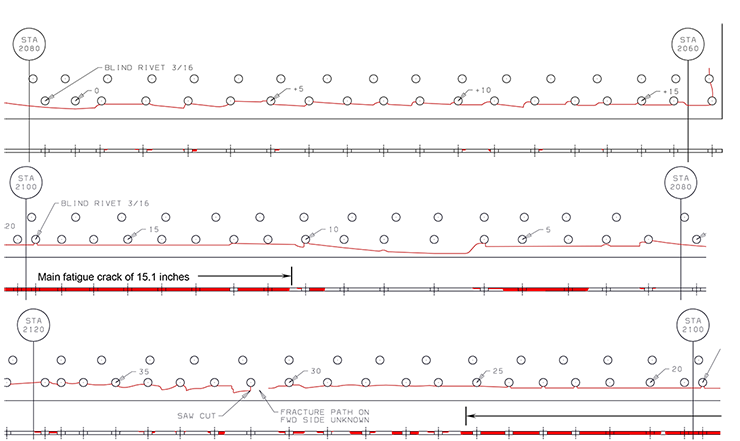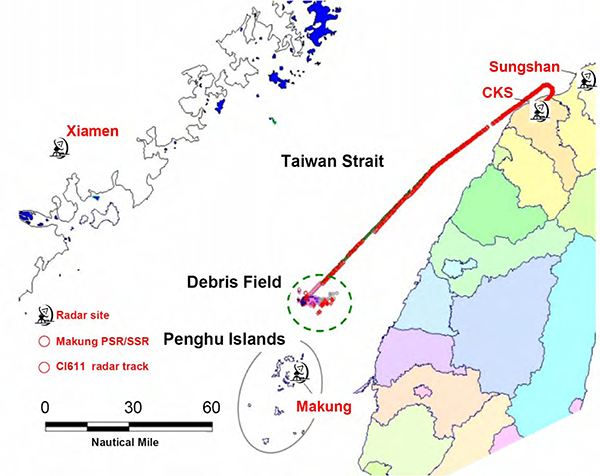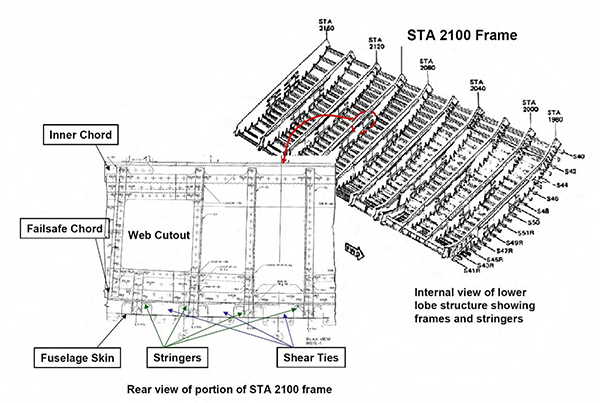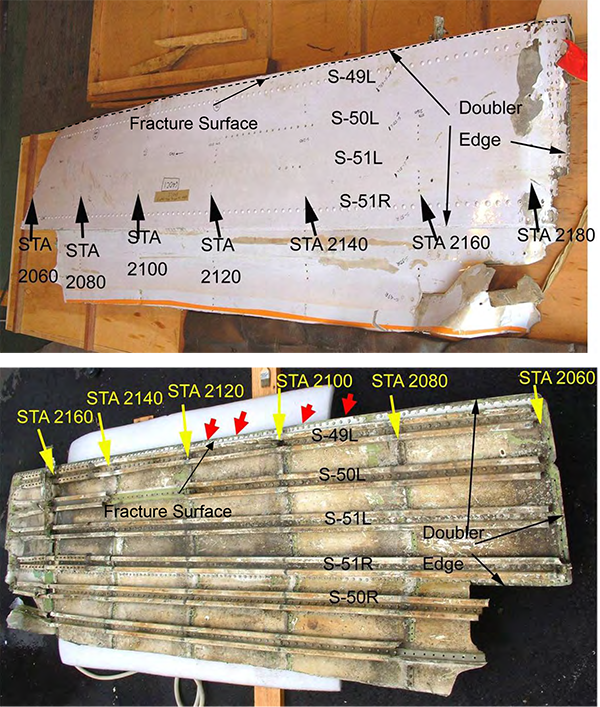There is a term in the safety business that isn't in a lot of literature because it illustrates a level of futility many of us are reluctant to face, and that term is "assumed safety." We assume a lot as pilots before releasing the brakes prior to takeoff. We assume the airplane was properly designed, maintained, and serviced. We assume those we share the skies with are also properly equipped. But sometimes those assumptions are wrong. Corporate aviation pilots can get into the nuts and bolts better than airline pilots, but we too are relying on a lot of other people to do their jobs properly. Sometimes we are just passengers in airplanes that are ticking time bombs. Case in point: China Airlines CI611.
— James Albright

Updated:
2016-07-09

Distribution of the fatigue cracks,
from ASC-AOR, Figure 1.16-12
This airplane had a tail strike that severely weakened part of the skin in the aft lower section. The airline did not repair the damage properly and failed to follow up with the necessary inspections over the years. I've left out much of the inspection history because we get enough of what went wrong through the repair. I've presented enough of the nuts and bolts to help us pilots understand what we should be looking for when inspecting damage repairs. A very thin crack or even a scrape can become a tear large enough to bring down the airplane. These imperfections are especially dangerous when around corners and holes. The repairs are painted over and sometimes there is nothing for you to see, as in this case. But you might see something that gives you a hint.
The Aviation Safety Council did an excellent job piecing this all together but I would have written the probable cause a little differently. I believe the cause was an airline management that encouraged short cuts to manufacturer repair procedures, mechanics who were either unaware they were not using correct repair techniques or agreed to these techniques despite their knowledge, and improper oversight from the Chinese authorities. This sort of maintenance malpractice is often deadly and in this case it was.

1
Accident report
- Date: 25 MAY 2002
- Time: 15:30
- Type: Boeing 747-209B
- Operator: China Airlines
- Registration: B-18255
- Fatalities: 19 of 19 crew, 206 of 206 passengers
- Aircraft Fate: Destroyed
- Phase: En route
- Airport: (Departure) Taipei-Chiang Kai Shek International Airport (TPE/RCTP), Taiwan
- Airport: (Destination) Hong Kong-Chek Lap Kok International Airport (HKG/VHHH), Hong Kong
2
Narrative

CI611 radar track, radar sites, and debris field from ASC-AOR-05-02-011, figure 1.8-1.
The takeoff and initial climb were normal. The flight contacted Taipei Approach at 1508:53, and at 1510:34, Taipei Approach instructed CI611 to fly direct to CHALI3. At 1512:12, CM-3 [the flight engineer] contacted China Airlines Operations with the time off-blocks, time airborne, and estimated time of arrival at Chek Lap Kok airport. At 1516:24, the Taipei Area Control Center controller instructed CI611 to continue its climb to flight level 350, and to maintain that altitude while flying from CHALI direct to KADLO 4 . The acknowledgment of this transmission, at 1516:31, was the last radio transmission received from the aircraft.
Radar contact with CI611 was lost by Taipei Area Control at 1528:03. An immediate search and rescue operation was initiated. At 1800, floating wreckage was sighted on the sea in the area 23 nautical miles northeast of Makung, Penghu Islands.
Source: ASC-AOR-05-02-011, ¶1.1
Based on the radar track data, the accident aircraft suffered an in-flight breakup as it approached its cruising altitude of 35,000 ft.
Source: ASC-AOR-05-02-011, ¶2.1
3
Analysis
Component Description

Description of the components of the lower lobe frame, from ASC-AOR-05-02-011, figure 1.6-1.
I flew the Boeing 747 for five years and was always impressed with its massive size. It is like seeing the Grand Canyon; photos do not do it justice. You get a false sense of security from the proportions. How can a ten inch crack bring down such a massive airplane? The key to understanding structures on any airplane is that every component works as part of the entire airplane. The skin itself plays a role in holding everything together.
- In the B747-200 fuselage, applied loads are supported by both the skin and by internal structure including frames, stringers, shear ties, and stringer clips.
- The skin of the aircraft is constructed from sheets of aluminum alloy. The sheets are connected with lap joints and butt joints. Lap joints run longitudinally (along the length of the aircraft) and have one sheet overlapping the adjacent sheet. Butt joints run circumferentially (around the cross-section of the fuselage) and are constructed with a splice plate to which is attached both adjoining skin sheets. The butt joint is so named because the skin sheets butt up against one another but do not overlap.
- Stringers are longitudinal stiffeners attached directly to the skin that run the length of the fuselage and are located around the periphery of the cross-section.
- Individual fuselage frames are located approximately every 20 inches along the length of the fuselage and conform to the cross-section of the aircraft. The frames themselves can be considered as beams with an upper and lower chord separated by a stiffened web. However, because the entire frame is approximately circular in shape, the chords are referred to as the inner chord and fail-safe (outer) chord. The inner chord essentially defines the interior cross-section of the cabin while the fail-safe chord of the frame is adjacent to the stringers. The fail-safe chords are so-named because they serve to help carry cabin pressurization loads (hoop tension) should a longitudinal crack develop in the skin.
- Shear ties connect fuselage frames to the fuselage skin and are located between stringers. Shear ties serve to transfer loads between the frame and skin and to transfer hoop tension loads from the skin to the frame fail-safe chord should a crack develop in the skin.
- Stringer clips are located at frame/stringer intersections and serve to connect the frames to the stringers.
Source: ASC-AOR-05-02-011, ¶1.6.1.2
Tail Strike and Subsequent Repairs
- On February 7, 1980, the accident aircraft suffered tail strike damage during landing on the runway in Kai Tec Airport, Hong Kong. Preliminary inspection at Hong Kong after the tail strike found abrasion damage on aft fuselage portion bottom skin between STA 2080 and STA 2160, and between STA 2578 and 2658. The aft drain mast was missing and the left outflow valve door inboard corner was partially cut.
- According to the CAL flight engineer’s report, the aircraft was ferried back to CKS unpressurized. There was no structural repair conducted at Kai-Tec Airport.
- A temporary repair was completed on February 08, 1980, per CAL Engineering Recommendation, ERE (747)-AS062, dated February 08, 1980. It stated:
- Close visual inspection to internal structure for any defect inside the abraded skin.
- Install two reinforcing doublers, made of 0.063” 7075-T6 aluminum. Alloy plates at two places of the abraded area, forward 23” by 125” (to be sealed during installation on this pressurized area) and aft 15” by 54”.
- Aft water drain mast reinstalled and functional test.
- Left outflow valve door cut area temporarily repair with 6061-T6 Aluminum alloy and functional test.
- Conduct permanent repair in accordance with B747 SRM [Structure Repair Manual] within four months.
- The temporary repair was concurred by the local Boeing Representative on February 7,1980.
- B-18255 Aircraft Logbook indicated that the aircraft was grounded for fuselage bottom repair from May 23 to 26, 1980. The “Major Repair and Overhaul Record“ page of the same logbook recorded the permanent repair dated May 25, 1980, which stated that the repair was accomplished per the Boeing SRM section 53-30-03.
- The Safety Council was not able to obtain any other engineering process records regarding the permanent repair of this specific area, i.e. a complete description of the nature and location of the damage; drawings/diagrams depicting the size and shape of the repair; applicable engineering guidance and maintenance instructions; work cards containing complete description of the steps to remove and repair the damage and the inspector’s signoffs. CAL informed the Safety Council that the B-18255 tail strike structural repair in 1980 was not considered by CAL to be a major repair.
- Regarding the permanent repair to the tail strike, Boeing stated that they “have found no record that indicates Boeing was advised that the permanent repair had been completed.”
Source: ASC-AOR-05-02-011, ¶1.6.2
Examination of a Repair Doubler Between STA 2060 to 2180 and S-49L to S-49R

Exterior (up) and interior (down) of Item 640C1, from ASC-AOR-05-02-011, figure 1.16-1.
Item 640C1 was a segment of Item 640 approximately from STA 2060 to 2180 and from S-49L to S-49R (Figure 1.16-1). A 23-inch wide, 125-inch long external repair doubler was attached to the skin by two rows of countersunk rivets around its periphery as well as by fasteners common to the stringer and shear tie locations. Universal head rivets were used at S-51R and S-49L while countersunk rivets were used at S-50L and S-51L.
Source: ASC-AOR-05-02-011, ¶1.16.3
A "faying surface" is the surface on a sheet of metal that faces another; once they are joined you cannot see the surface.
After disassembling the doubler from the skin and removal of the protective finishes, scratching damage was noticed on the faying surface of the skin. This damage consists of primarily longitudinal scratching distributed in an area of 120 inches by 20 inches. The most severe scratching typically occurred at the skin stiffening members such as skin stringers and body frame shear ties. Evidence of an attempt to blend out these skin scratches, in the form of rework sanding marks, was noted over much of the repair surface.
Source: ASC-AOR-05-02-011, ¶1.16.3
Scratching leaves stress points in the metal, even when the surface is sanded smooth.
Corrosion was noted at several shear tie locations on the skin inboard surface sometimes penetrating completely through the skin thickness.
One additional observation described in the BMT [Boeing Materials Technology Laboratory] report is the large percentage of the overdriven rivets on the repair doubler. Out of 402 rivets, 267 were found overdriven (66%), 15 were under driven (3.7%), and the rest 120 appeared to be normal (29.8%).
Source: ASC-AOR-05-02-011, ¶1.16.3
A rivet that is underdriven could allow movement of the joined surfaces and create undue stress at the rivet. A rivet that is overdriven can weaken the structure around the rivet.
The FSR [Boeing Field Service Representative] stated that according to SRM, the permanent repair should cut out the damaged skin, add filler, and place a doubler to cover the damaged area. The doubler must oversize the filler by at least three rows of rivets. If the stringer was damaged, it should be fixed per SRM as well.
The FSR stated that usually the temporary repair was to place an external doubler outside the damaged area (did not cut out the damaged area). He did not know whether the CAL had conducted the permanent repair or not because he did not actually see the repair. The CAL did not inform him when the repair was carried out. The FSR stated that the CAL had QC system to monitor the maintenance operations. CAL did not need a Boeing FSR when it carried out the repair operation. The CAL did not report to Boeing when the permanent repair was completed.
Source: ASC-AOR-05-02-011, ¶1.17.2.3.1
- After examining wreckage items 640 and 630, the Safety Council concludes that the May 1980 repair to the tail strike damage area of the accident aircraft was not accomplished in accordance with the Boeing SRM. Specifically, the Boeing SRM allows scratches in the damaged skin within allowable limits to be blended out. If, however, the damage was too severe and beyond allowable limits, the damaged skin had to be cut off and a doubler was to be installed, or the old skin was to be replaced with piece of new skin. The damaged skin of B-18255 was beyond the allowable limit and scratches remained on the skin.
- Examination of wreckage item 640 indicated that the maximum depth of scratches after the clean up was about 13.5% (0.0096 inch) of the skin thickness and the length of the scratches on the damaged skin was more than 20 inches. In addition, several scratches passed directly through fastener locations. The damage was beyond the allowable damage specified by the SRM. Repairs could be made by replacing the entire affected skin or cutting out the damaged portion and installing a reinforcing doubler to restore the structural strength. Instead either of these acceptable options, a doubler was installed over the scratched skin. In addition, the external doubler did not effectively cover the entire damaged area as scratches were found at and outside the outer row of fasteners securing the doubler. When the doubler was installed with some scratches outside the rivets, there was no protection against the propagation of a concealed crack in the area between the rivets and the perimeter of the doubler.
- Based on observations of the wreckage, the Safety Council concludes that the maintenance methods and procedures regarding the repairs to the damaged area of B-18255 did not comply with the content of the SRM. As a result, since the 1980 repair, the accident aircraft had been operated with an inadequate repair and subsequent deterioration was not detected during routine maintenance and other inspections.
Source: ASC-AOR-05-02-011, ¶2.3.1.1
Evidence of Rapid Depressurization
Dado vent modules are installed in the lower portion of the passenger cabin sidewalls just above the floor at selected locations throughout the aircraft. The vent box modules incorporate a dado panel and a louvered air grille as part of a hinged and spring-loaded door. In normal operation, the hinged door is held in the closed position by an over-centered valve mechanism. In the event of a rapid decompression originating in the lower lobe, the differential pressure between the main deck and lower lobe will trip the valve and the hinged door will swing open into the sidewall to provide additional venting to prevent structural collapse of the floor. Once open, the hinged door will remain in the open position until each individual door is manually reset.
Nineteen out of 65 installed dado panels were recovered. The position of seven of the recovered panels could not be determined. Of the remaining 12 recovered panels, 8 were from the forward section of the aircraft (zones B, and C), and were found to be in the “closed” position. The other four (two from zone D and two from zone E) were found in the “open” position. The recovered dado panels suggest that the aircraft experienced a rapid decompression in the aft lower lobe area and the dado panels in this area opened to balance the lower pressure in the lower lobe.
Source: ASC-AOR-05-02-011, ¶2.2.2
Evidence of fatigue crack was found and confirmed by both CSIST [Chung-Shan Institute of Science and Technology] and BMT on the piece of wreckage identified as Item 640. There was a cumulative length of 25.4 inches, including a 15.1-inch continuous fatigue crack and other smaller fatigue cracks aft and forward extending from hole +14 to hole 51.
Based on the findings from CSIST and BMT, the Safety Council examined the origin of the fatigue cracks and the length of the existing continuous crack in the skin prior to the in-flight breakup in this subsection.
Source: ASC-AOR-05-02-011, ¶2.2.6
Summary
- Examination of wreckage item 640 skin shows that many longitudinal scratches (fore to aft) existed on the faying surface of the skin. An attempt to blend out of these scratches was also apparent from the rework sanding marks. Those scratches and sanding marks were related to the 1980 tail strike event of the accident aircraft.
- Fatigue cracks were found on wreckage Item 640. There was a cumulative length of approximately 25.4 inches, including a 15.1-inch fatigue crack and other smaller fatigue cracks aft and forward extending from hole +14 to hole 51. The fatigue crack pattern shows an increasing growth rate through thickness and propagating inward. This can be attributed to the cracks growing from many origins on the skin surface at the scratch locations.
- The increasing differential pressure as the accident aircraft climbed and approached to its designated cruising altitude 35,000 feet, enabled the pre-existing cracks, centered about STA 2100 and S-49L, to reach the length that reduced the residual strength to its operating limits, and resulted in an unstable separation, along with a rapid loss of cabin pressure.
- The fracture progressed towards the upper skin and severed the power wiring to the CVR and FDR, before any significant anomaly could be recorded.
- Pieces of wreckage from section 46 began separating on either side of the fuselage. The separating debris from the right side of the belly struck the vertical fin as evidenced by a section of stringers found stuck inside the fin. Once the structural integrity of the remaining portion of section 46 could no longer support the loads, the entire empennage separated from the aircraft.
Source: ASC-AOR-05-02-011, ¶2.2.8
4
Cause
- Based on the recordings of CVR and FDR, radar data, the dado panel open-close positions, the wreckage distribution, and the wreckage examinations, the in-flight breakup of CI611, as it approached its cruising altitude, was highly likely due to the structural failure in the aft lower lobe section of the fuselage.
- In February 7 1980, the accident aircraft suffered a tail strike occurrence in Hong Kong. The aircraft was ferried back to Taiwan on the same day unpressurized. and a temporary repair was conducted the day after. A permanent repair was conducted on May 23 through 26, 1980.
- The permanent repair of the tail strike was not accomplished in accordance with the Boeing SRM, in that the area of damaged skin in Section 46 was not removed (trimmed) and the repair doubler did not extend sufficiently beyond the entire damaged area to restore the structural strength.
- Evidence of fatigue damage was found in the lower aft fuselage centered about STA 2100, between stringers S-48L and S-49L, under the repair doubler near its edge and outside the outer row of securing rivets. Multiple Site Damage (MSD), including a 15.1-inch through thickness main fatigue crack and some small fatigue cracks were confirmed. The 15.1-inch crack and most of the MSD cracks initiated from the scratching damage associated with the 1980 tail strike incident.
- Residual strength analysis indicated that the main fatigue crack in combination with the Multiple Site Damage (MSD) were of sufficient magnitude and distribution to facilitate the local linking of the fatigue cracks so as to produce a continuous crack within a two-bay region (40 inches). Analysis further indicated that during the application of normal operational loads the residual strength of the fuselage would be compromised with a continuous crack of 58 inches or longer length. Although the ASC could not determine the length of cracking prior to the accident flight, the ASC believes that the extent of hoop-wise fretting marks found on the doubler, and the regularly spaced marks and deformed cladding found on the fracture surface suggest that a continuous crack of at least 71 inches in length, a crack length considered long enough to cause structural separation of the fuselage, was present before the in-flight breakup of the aircraft.
- Maintenance inspection of B-18255 did not detect the ineffective 1980 structural repair and the fatigue cracks that were developing under the repair doubler. However, the time that the fatigue cracks propagated through the skin thickness could not be determined.
Source: ASC-AOR-05-02-011, ¶3.1
References
(Source material)
Aviation Occurrence Report Volume I, ASC-AOR-05-02-011, In-flight Breakup Over the Taiwan Strait Northeast of Makung, Penghu Island, China Airlines Flight CI611, Boeing 747-200, B-18255, May 25, 2002, Aviation Safety Council
Aviation Occurrence Report Volume II, ASC-AOR-05-02-001, In-flight Breakup Over the Taiwan Strait Northeast of Makung, Penghu Island, China Airlines Flight CI611, Boeing 747-200, B-18255, May 25, 2002, Aviation Safety Council